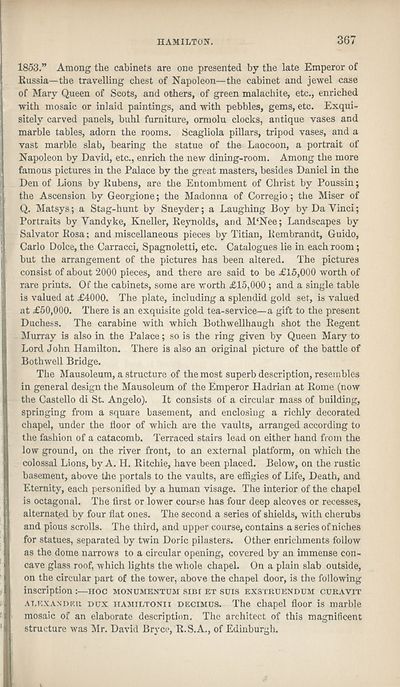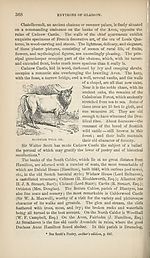Download files
Complete book:
Individual page:
Thumbnail gallery: Grid view | List view

HAMILTON.
367
1863.” Among the cabinets are one presented by the late Emperor of
Kussia—the travelling chest of Napoleon—the cabinet and jewel case
of Mary Queen of Scots, and others, of green malachite, etc., enriched
with mosaic or inlaid paintings, and with pebbles, gems, etc. Exqui¬
sitely carved panels, buhl furniture, ormolu clocks, antique vases and
marble tables, adorn the rooms. Scagliola pillars, tripod vases, and a
vast marble slab, bearing the statue of the Laocoon, a portrait of
Napoleon by David, etc., enrich the new dining-room. Among the more
famous pictures in the Palace by the great masters, besides Daniel in the
Den of Lions by Rubens, are the Entombment of Christ by Poussin;
the Ascension by Georgione; the Madonna of Corregio; the Miser of
Q. Matsys; a Stag-hunt by Sneyder; a Laughing Boy by Da Vinci;
Portraits by Vandyke, Kneller, Reynolds, and M‘Nee; Landscapes by
Salvator Rosa; and miscellaneous pieces by Titian, Rembrandt, Guido,
Carlo Dolce, the Carracci, Spagnoletti, etc. Catalogues lie in each room;
but the arrangement of the pictures has been altered. The pictures
consist of about 2000 pieces, and there are said to be £16,000 worth of
rare prints. Of the cabinets, some are worth £15,000; and a single table
is valued at £4000. The plate, including a splendid gold set, is valued
at £50,000. There is an exquisite gold tea-service—a gift to the present
Duchess. The carabine with which Bothwellhaugh shot the Regent
Murray is also in the Palace; so is the ring given by Queen Mary to
Lord John Hamilton. There is also an original picture of the battle of
Bothwell Bridge.
The Mausoleum, a structure of the most superb description, resembles
in general design the Mausoleum of the Emperor Hadrian at Rome (now
the Gastello di St. Angelo). It consists of a circular mass of building,
springing from a square basement, and enclosing a richly decorated
chapel, under the floor of which are the vaults, arranged according to
the fashion of a catacomb. Terraced stairs lead on either hand from the
low ground, on the river front, to an external platform, on which the
colossal Lions, by A. H. Ritchie, have been placed. Below, on the rustic
basement, above the portals to the vaults, are effigies of Life, Death, and
Eternity, each personified by a human visage. The interior of the chapel
is octagonal. The first or lower course has four deep alcoves or recesses,
alternated by four flat ones. The second a series of shields, with cherubs
and pious scrolls. The third, and upper course, contains a series of niches
for statues, separated by twin Doric pilasters. Other enrichments follow
as the dome narrows to a circular opening, covered by an immense con¬
cave glass roof, which lights the whole chapel. On a plain slab outside,
on the circular part of the tower, above the chapel door, is the following
inscription:—hoc monumentum sibi et sdis exstruendum curavit
ALEXANDER dux hamiltonh decimus. The chapel floor is marble
mosaic of an elaborate description. The architect of this magnificent
structure was Mr. David Brvco. R.S.A.. of Edinburgh.
367
1863.” Among the cabinets are one presented by the late Emperor of
Kussia—the travelling chest of Napoleon—the cabinet and jewel case
of Mary Queen of Scots, and others, of green malachite, etc., enriched
with mosaic or inlaid paintings, and with pebbles, gems, etc. Exqui¬
sitely carved panels, buhl furniture, ormolu clocks, antique vases and
marble tables, adorn the rooms. Scagliola pillars, tripod vases, and a
vast marble slab, bearing the statue of the Laocoon, a portrait of
Napoleon by David, etc., enrich the new dining-room. Among the more
famous pictures in the Palace by the great masters, besides Daniel in the
Den of Lions by Rubens, are the Entombment of Christ by Poussin;
the Ascension by Georgione; the Madonna of Corregio; the Miser of
Q. Matsys; a Stag-hunt by Sneyder; a Laughing Boy by Da Vinci;
Portraits by Vandyke, Kneller, Reynolds, and M‘Nee; Landscapes by
Salvator Rosa; and miscellaneous pieces by Titian, Rembrandt, Guido,
Carlo Dolce, the Carracci, Spagnoletti, etc. Catalogues lie in each room;
but the arrangement of the pictures has been altered. The pictures
consist of about 2000 pieces, and there are said to be £16,000 worth of
rare prints. Of the cabinets, some are worth £15,000; and a single table
is valued at £4000. The plate, including a splendid gold set, is valued
at £50,000. There is an exquisite gold tea-service—a gift to the present
Duchess. The carabine with which Bothwellhaugh shot the Regent
Murray is also in the Palace; so is the ring given by Queen Mary to
Lord John Hamilton. There is also an original picture of the battle of
Bothwell Bridge.
The Mausoleum, a structure of the most superb description, resembles
in general design the Mausoleum of the Emperor Hadrian at Rome (now
the Gastello di St. Angelo). It consists of a circular mass of building,
springing from a square basement, and enclosing a richly decorated
chapel, under the floor of which are the vaults, arranged according to
the fashion of a catacomb. Terraced stairs lead on either hand from the
low ground, on the river front, to an external platform, on which the
colossal Lions, by A. H. Ritchie, have been placed. Below, on the rustic
basement, above the portals to the vaults, are effigies of Life, Death, and
Eternity, each personified by a human visage. The interior of the chapel
is octagonal. The first or lower course has four deep alcoves or recesses,
alternated by four flat ones. The second a series of shields, with cherubs
and pious scrolls. The third, and upper course, contains a series of niches
for statues, separated by twin Doric pilasters. Other enrichments follow
as the dome narrows to a circular opening, covered by an immense con¬
cave glass roof, which lights the whole chapel. On a plain slab outside,
on the circular part of the tower, above the chapel door, is the following
inscription:—hoc monumentum sibi et sdis exstruendum curavit
ALEXANDER dux hamiltonh decimus. The chapel floor is marble
mosaic of an elaborate description. The architect of this magnificent
structure was Mr. David Brvco. R.S.A.. of Edinburgh.
Set display mode to:
![]() Universal Viewer |
Universal Viewer | ![]() Mirador |
Large image | Transcription
Mirador |
Large image | Transcription
| Antiquarian books of Scotland > Scotland/Scots > Black's picturesque tourist of Scotland > (479) |
|---|
| Permanent URL | https://digital.nls.uk/130033938 |
|---|
| Description | Thousands of printed books from the Antiquarian Books of Scotland collection which dates from 1641 to the 1980s. The collection consists of 14,800 books which were published in Scotland or have a Scottish connection, e.g. through the author, printer or owner. Subjects covered include sport, education, diseases, adventure, occupations, Jacobites, politics and religion. Among the 29 languages represented are English, Gaelic, Italian, French, Russian and Swedish. |
|---|

